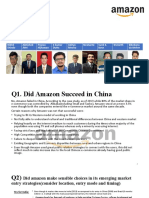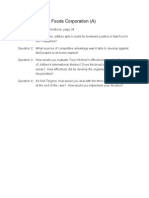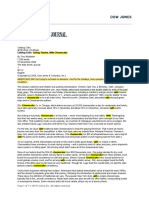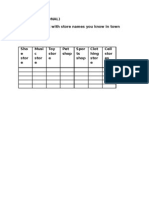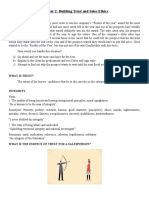IKEA: Design and Pricing: Case
IKEA: Design and Pricing: Case
Uploaded by
balal_hossain_1Copyright:
Available Formats
IKEA: Design and Pricing: Case
IKEA: Design and Pricing: Case
Uploaded by
balal_hossain_1Original Description:
Original Title
Copyright
Available Formats
Share this document
Did you find this document useful?
Is this content inappropriate?
Copyright:
Available Formats
IKEA: Design and Pricing: Case
IKEA: Design and Pricing: Case
Uploaded by
balal_hossain_1Copyright:
Available Formats
Design of Products and Services
Chapter 3 69
13. The following chart is a partial house of quality for a golf country club. Provide
an importance weighting from your perspective (or that of a golfing friend) in the
unshaded areas. If you can, using the QFD approach, compare it to a club where you or
your friends play.
Customer-trained attendants
Calloway handicapping
Grounds maintenance
Exciting door prizes
Attractive restaurant
Tournament Activities
Highly rated chefs
Top-quality food
Course location
Types of guests
Income level
Perception Issues
Service Facilities
Invitation only
Tee placement
Physical Aspects
Pin placement
Course tuning
Landscaping
Celebrity
WHATs versus HOWs
Strong Relationship:
Medium Relationship:
Weak Relationship:
Physical Aspects
Manicured grounds
Easy access
Challenging
Service Facilities
Restaurant facilities
Good food
Good service
Good layout
Plush locker room
Helpful service attendants
Tournament Facilities
Good tournament prize
Types of players
Fair handicapping system
Perception Issues
Prestigious
Case: IKEA: Design and Pricing
The Swedish retailer dominates markets in 32 countries, ever making customers feel cheap. Striking that balance
and now it’s poised to conquer North America. Its battle demands a special kind of design, manufacturing, and
plan: Keep making its offerings less expensive, without distribution expertise. But IKEA pulls it off in its own
making them cheap. distinctive way: tastefully, methodically, even cheerfully,
Above all else, one factor accounts for IKEA’s suc- and yet somehow differently than any other company
cess: good quality at a low price. IKEA sells house- anywhere. Here’s a step-by-step guide to how IKEA
hold items that are cheap but not cheapo, at prices that designs, builds, and distributes the items that the entire
typically run 30 to 50 percent below the competition’s. world wants to buy.
While the price of other companies’ products tends to The Trofé mug is one of the most popular IKEA prod-
rise over time, IKEA says it has reduced its retail prices ucts. The story of the mug is an example of how IKEA
by a total of about 20 percent during the past four years. works, from a co-worker’s bright idea through to produc-
At IKEA, the process of driving down costs starts the tion and sales. It is also a story about all the demands
moment a new item is conceived and continues relent- that customers place on IKEA. A low price tag is the
lessly throughout its production run. The price of a basic obvious one, but other requirements include function,
Pöang chair, for example, has fallen from $149 in 2000 to modern design, environmental considerations, and mak-
$99 in 2001 to $79 today. IKEA expects the most recent ing sure products have been manufactured under accept-
price cut to increase Pöang sales by 30 to 50 percent. able working conditions. Both customers and co-workers
IKEA’s corporate mantra is “Low price with mean- must be able to rely on IKEA.
ing.” The goal is to make things less expensive without
70 Section 1 Strategy, Products, and Capacity
Step 1. Pick a Price environmental considerations can influence the develop-
Product Development—A sketch for a new product? Yes, ment of products. For example, the new mug is lighter in
but it’s also a calculation of what that product will cost. color—a move that cuts costs and is more environmen-
The low price begins at the drawing board. tally friendly. The less pigment that is used, the better.
The team behind each product consists of designers, The mug is also lead- and cadmium-free.
product developers, and purchasers who get together to
discuss design, materials, and suitable suppliers. Everyone Step 3. Design the Product
contributes with their specialist knowledge. Purchasers, With a price point and a manufacturer in place, IKEA
for example, use their contacts with suppliers all over the once again uses internal competition to find a designer
world via IKEA Trading Service Offices. Who can make and select a design for production. The designer begins
this at the best quality for the right price at the right time? the design process by writing a brief that explains the
When product developers were given the task of creat- product’s price, its function, the materials to be used,
ing a new mug over five years ago, they were told how and the fabricator’s capabilities. The designer then sends
much it should cost in the stores. In the case of Trofé, the brief to IKEA’s staff designers and freelancers, and
the price had to be incredibly low—five Swedish kronor! refines promising designs until settling on the one to pro-
This mug had to have a real knockout price. duce. The designer wants products to be like Swiss Army
To produce the right mug at the right price, the devel- knives—to get maximum functionality at minimum cost.
opers had to take into account materials, colors, and
design. For example, the mug is made in green, blue, yel- Step 4. Ship It
low, or white because these pigments cost less than other Distribution and logistics are the lifeblood of IKEA and
shades, such as red. important pieces of the puzzle on the road to a low price.
IKEA strives to deliver the right number of goods to
Step 2. Choose a Manufacturer the right stores at the right time. It calculates the goods
Suppliers and Purchasing—The task of developing requirements and makes sure that deliveries are efficient.
products never ends. Working with suppliers, the mug Each pallet holds 2,024 mugs, which are transported
was shortened and the handle changed so it stacks more from Romania by rail, road, and sea to IKEA distribution
efficiently, saving space for transport, warehousing, and centers around the world. Transportation does, of course,
store display—and, not least, in the customers’ cupboards have an effect on the environment, but IKEA is working
at home. IKEA is always keen to banish as much air as toward reducing environmental impact.
possible from its packaging. Packages should preferably Many of IKEA’s products are bulky—for example,
be flat for efficient transport and storage. tables and chairs. IKEA pioneered the concept of flat.
One supplier, a factory in Romania, has worked with The company’s eureka moment occurred in 1956, when
IKEA for 15 years. Long-term relationships help both par- one of IKEA’s first designers watched a customer trying
ties to build up a huge fund of knowledge about demands to fit a table into his car. There was only one way to do
and expectations. That is why products are often devel- it: Remove the legs. From that day forward, most IKEA
oped in close cooperation with suppliers. In the case of products have been designed to ship disassembled, flat
Trofé, for example, the new size has rationalized produc- enough to be slipped into the cargo hatch of a station
tion by making better use of the space in the kiln during wagon or safely tied down on an auto’s roof rack.
the firing process. That’s cost-effective and saves time. In IKEA’s innately frugal corporate culture, where
IKEA has introduced a code of conduct govern- waste has been declared a “deadly sin,” the flat pack-
ing working conditions and environmental awareness age is also an excellent way to lower shipping costs by
among suppliers. This deals with matters such as health maximizing the use of space inside shipping containers.
and safety in the workplace and forbids the use of child The company estimates transport volume would be six
labor. The practical work of implementing this code of times greater if its items were shipped assembled. From
conduct is carried out by co-workers in IKEA Trading the design studio to the warehouse floor, IKEA employ-
Service Offices worldwide. Many suppliers already meet ees’ mantra is always the same: “We don’t want to pay to
the demands; others are working together with IKEA to ship air.”
carry out the necessary improvements. IKEA also works Making things flat is an IKEA obsession. How many
closely with external quality control and audit compa- times can you redesign a simple fired-clay coffee mug?
nies that check that IKEA and its suppliers live up to the IKEA’s mug was redesigned three times—simply to
requirements of the code of conduct. maximize the number of them that could be stored on a
The low price tag is crucial to the vision IKEA has of pallet. Originally, only 864 mugs would fit. A redesign
creating a better everyday life for many people. That is added a rim such as you’d find on a flowerpot, so that
why IKEA works nonstop to reduce costs. But it’s also each pallet could hold 1,280 mugs. Yet another redesign
a question of saving raw materials and, ultimately, the created a shorter mug with a new handle, allowing 2,024
environment. The low-cost mug is one example of how to squeeze onto a pallet. While the mug’s sales price has
Design of Products and Services Chapter 3 71
remained at 50 cents, shipping costs have been reduced taking them home, and using the instructions enclosed to
by 60 percent, which is a significant savings, given that assemble them. Many will have already chosen the prod-
IKEA sells about 25 million of the mugs each year. Even ucts from the IKEA catalog, of which 110 million copies
better, the cost of production at IKEA’s Romanian factory are printed in 34 different language versions.
also has fallen because the more compact mugs require When you walk through the door of an IKEA store, you
less space in the kiln. enter a meticulously constructed virtual Sweden. The first
When you ship 25 million cubic meters of goods all thing you encounter is a company-sponsored child-care
over the globe, flat-pack frugality adds up. IKEA now facility. Hungry? Have some of those Swedish meatballs
uses a 65 percent average fill-rate target for all the con- and lingonberries. The layout of an IKEA store guides
tainers it ships, and it hopes to increase that to 75 percent. shoppers in a predetermined path past several realistic
Meeting that goal will require further design changes and model homes, which convey an eerily lived-in impression
sometimes even sucking the air out of items (like IKEA’s but are open for customers to sit in. Information kiosks
shrink-wrapped pillows, which look like giant crackers on provide advice on home decor. Color-coordinated cards
store shelves). And, of course, flat packing shifts the cost offer plenty of suggestions on offbeat uses for products.
of product assembly to the customer, saving even more. But the emphasis is always on price. Low-priced prod-
As IKEA has shifted more of its buying from Europe ucts that IKEA calls BTIs (“breathtaking items”) are
to the Far East, shipping time and costs have become an often perched on risers, framed by a huge yellow price
even more critical concern. Last year, China tied S weden tag. Nearby, shoppers will find other products—pricier,
atop IKEA’s list of supplier countries. The company more design-oriented—as substitutes for the BTI.
has responded by creating a global network of distribu- The model homes suggest cheerful young people
tion centers, most of which are near container ports and throwing dinner parties in hallways, using mismatched
major truck and rail routes. There are 18 IKEA distribu- office chairs and narrow side tables. These aren’t the
tion centers worldwide—which handle about 70 percent aspirational images you’ll find at Pottery Barn or Crate
of IKEA’s total product line—and 4 more are under con- & Barrel. These are people who are living well in mod-
struction. The other 30 percent of IKEA’s products travel est circumstances—frugal folks who know the value of a
directly from supplier to store. comfortable place to sit.
Sometimes, however, product components actually IKEA says its biggest selling point is the price tag,
come together for the first time in the store. In the case of but it can’t hurt that getting through one of IKEA’s
the Pöang chair, the cushion comes from Poland and the huge stores takes a lot of time. The layout is blatantly
frame from China. The two pieces are united only when manipulative—though in a friendly, knowing way, not
the customer pulls each one off the shelf. unlike at Disneyland—but when customers finally arrive
at the checkout counter, they’ve had plenty of time to
Step 5. Sell It fully consider their purchases.
IKEA sells a lot of expensive furniture, and in a traditional IKEA products broadcast an ethos for living in the
store this is relatively easy: Put a piece in a lush setting, modern world: Don’t buy an ugly pitcher if you can get a
let the customer fall prey to visions of wealth and comfort, stylish one for the same price. If you organize your plas-
then offer plenty of easy credit. But to keep prices low, tic bags, you’ll feel more in control of your life. It’s left-
IKEA needs to sell furniture and other products such as brain logic applied to the right-brain art of living well.
the mug without salespeople or conspicuous price reduc- And if happiness involves dragging a cumbersome flat
tions. The company asks customers to assemble their fur- package off the shelf, standing in line at the checkout,
niture themselves. And IKEA doesn’t want to ship it to you hauling the box home, and spending hours assembling a
either. By any conventional measure, these are formidable kitchen cabinet, well, 260 million customers a year are
hurdles to overcome. Yet they also explain why IKEA willing to make that trade-off.
has worked so hard to create a separate world inside its And, of course, next year it will be even cheaper.
stores—a kind of theme park masquerading as a furniture
outlet—where normal rules and expectations don’t apply. Questions
The Trofé mugs arrive at IKEA stores packed on pal- 1 . What are IKEA’s competitive priorities?
lets. Any transportation packaging is collected for recy- 2. Describe IKEA’s process for developing a new
cling. Price tags have already been placed on the mugs at product.
the suppliers. In-store display is important. It’s not just a 3. What are additional features of the IKEA concept
question of displaying mugs and other products. It’s also (beyond its design process) that contribute to creat-
about providing inspiration for smart interior solutions. ing exceptional value for the customer?
Customers contribute to the low prices at IKEA by select- 4. What would be important criteria for selecting a
ing and collecting the products from the self-serve area, site for an IKEA store?
Source: Information about the Trofé coffee mug was obtained from www.ikea.com.
You might also like
- Strategic ManagementDocument12 pagesStrategic ManagementYour TutorNo ratings yet
- GloBus Midterm ReviewDocument18 pagesGloBus Midterm ReviewMatthew StojkovNo ratings yet
- IKEA Case Study: Q.1 What Are IKEA's Competitive Priorities? Answer 1Document2 pagesIKEA Case Study: Q.1 What Are IKEA's Competitive Priorities? Answer 1Maulesh PatelNo ratings yet
- Management Study Case - Martinez ConstructionDocument5 pagesManagement Study Case - Martinez ConstructionCristina IonescuNo ratings yet
- MACROENVIRONMENT BaruuuuDocument4 pagesMACROENVIRONMENT BaruuuuAinie ZatyNo ratings yet
- Cityu2c Group1 NescafeDocument18 pagesCityu2c Group1 NescafeAnonymous rWXvxVACNo ratings yet
- Kate Spade Supply Chain AssessmentDocument9 pagesKate Spade Supply Chain AssessmentThilak Ramanathan100% (1)
- WCM of PBLDocument24 pagesWCM of PBLbalal_hossain_1No ratings yet
- Report On Akshaya PatraDocument15 pagesReport On Akshaya PatraMahabalaNo ratings yet
- Case 9: Amazon in Emerging MarketsDocument7 pagesCase 9: Amazon in Emerging MarketsAaditya ByadwalNo ratings yet
- Ceylon Tea Expand in JapanDocument21 pagesCeylon Tea Expand in JapanShiromi Udayangani Herath100% (3)
- Bitis Product Development 1 1Document12 pagesBitis Product Development 1 1Khánh LyNo ratings yet
- Case DELL Overtake HP Final - EdDocument20 pagesCase DELL Overtake HP Final - Edas1klh0No ratings yet
- Dusk at Dell Whats Wrong With The Companys StrategyDocument20 pagesDusk at Dell Whats Wrong With The Companys StrategyRajesh_Meena_3161No ratings yet
- Analyzing Sony and Biti's Case StudyDocument15 pagesAnalyzing Sony and Biti's Case Studytran chiNo ratings yet
- IKEA in ChinaDocument11 pagesIKEA in ChinaMetta YunitaNo ratings yet
- Maruti Suzuki Case StudyDocument25 pagesMaruti Suzuki Case StudyShrey KashyapNo ratings yet
- Business Environment: A Conceptual FrameworkDocument15 pagesBusiness Environment: A Conceptual FrameworkShelly GuptaNo ratings yet
- INDE7390 Case13Document1 pageINDE7390 Case13chuczyNo ratings yet
- Week 8 Problem Set 8.docmDocument9 pagesWeek 8 Problem Set 8.docminfobrains05No ratings yet
- Nike PhilosophyDocument3 pagesNike PhilosophyShahin ShadfarNo ratings yet
- Cost AccountingDocument64 pagesCost AccountingKrestyl Ann GabaldaNo ratings yet
- Quality Management: Ikea Case StudyDocument5 pagesQuality Management: Ikea Case StudyXuân HươngNo ratings yet
- What Is A Perceptual MapDocument6 pagesWhat Is A Perceptual MapFaidz FuadNo ratings yet
- Groupon in China ICB Report FinalDocument21 pagesGroupon in China ICB Report FinalMốc NhuNo ratings yet
- giải case study marketinggggDocument7 pagesgiải case study marketinggggHTGamer MonsterNo ratings yet
- Segmentation and TargetingDocument2 pagesSegmentation and TargetingTrang Nguyễn ThịNo ratings yet
- Capital StructureDocument41 pagesCapital Structure/jncjdncjdnNo ratings yet
- Chapter 6 - The Corporate Parent and Value CreationDocument22 pagesChapter 6 - The Corporate Parent and Value CreationDean Julienne50% (2)
- Final Quality ProjectDocument3 pagesFinal Quality ProjectAmit Yadav100% (1)
- DR DreDocument2 pagesDR Dregul bhutta100% (1)
- Competitive Strategy in Fragmented IndustriesDocument2 pagesCompetitive Strategy in Fragmented IndustriesJahnab GogoiNo ratings yet
- Masan Group CorporationDocument31 pagesMasan Group Corporationhồ nam longNo ratings yet
- Sony CSRDocument15 pagesSony CSRHemal Patel100% (1)
- Reading Material - Week 2.1 - How IKEA Saves Millions Through Packaging OptimizationDocument4 pagesReading Material - Week 2.1 - How IKEA Saves Millions Through Packaging Optimizationreyhan saputraNo ratings yet
- How Lenovo Created A World-Class Supply ChainDocument15 pagesHow Lenovo Created A World-Class Supply ChainVeneranda AtriaNo ratings yet
- Answers To The Case Study - Financial Report AnalysisDocument4 pagesAnswers To The Case Study - Financial Report AnalysisJohn Shiju100% (2)
- MAN 385.33 - Managing and Marketing in The Global Arena - Doggett - 04720Document18 pagesMAN 385.33 - Managing and Marketing in The Global Arena - Doggett - 04720Caro GrNo ratings yet
- Chapter 4Document2 pagesChapter 4Trung LêNo ratings yet
- PESTLE & SWOT AnalysisDocument14 pagesPESTLE & SWOT AnalysisSahmi Abdulqahar NizoriNo ratings yet
- Starbucks - Value Based PricingDocument8 pagesStarbucks - Value Based PricingVaibhav PandeyNo ratings yet
- Obstacles Faced by HondaDocument4 pagesObstacles Faced by HondaAyesha KhanNo ratings yet
- Unilever Pestle AnalysisDocument4 pagesUnilever Pestle AnalysisJackson KasakuNo ratings yet
- Deseratation Analysis SugDocument32 pagesDeseratation Analysis SugSarath SivadasanNo ratings yet
- Me A1.1Document9 pagesMe A1.1Truong QuyenNo ratings yet
- HRM-3@4 Case StudyDocument6 pagesHRM-3@4 Case Studysaddam.islmNo ratings yet
- DocDocument17 pagesDocsimarjeet singh100% (2)
- Damar International: Case DiscussionDocument1 pageDamar International: Case DiscussionJainish PorwalNo ratings yet
- Vrio Analysis:-: Feature Value Rarity Imiatability Organisation ResultDocument1 pageVrio Analysis:-: Feature Value Rarity Imiatability Organisation Resultsandeep kumar50% (2)
- Lesson 6 EBBADocument112 pagesLesson 6 EBBAThao Thu VuongNo ratings yet
- Cluster Analysis GodrejDocument4 pagesCluster Analysis GodrejSachinNo ratings yet
- IBS Case Study QuestionsDocument6 pagesIBS Case Study QuestionsJessica Luu100% (1)
- Project Supply Chain Management: Perishable Products (Restaurant Chain)Document34 pagesProject Supply Chain Management: Perishable Products (Restaurant Chain)Ryan GambleNo ratings yet
- Human Resource ProjectDocument14 pagesHuman Resource Projectdpalmer212No ratings yet
- The Secret of Disney's SuccessDocument12 pagesThe Secret of Disney's SuccessRoksoliana PankovskaNo ratings yet
- Sim92562 ch03 PDFDocument48 pagesSim92562 ch03 PDFSreekumar RajendrababuNo ratings yet
- Case Study Analysis of Toyota Motor: Prattayadutta T-23-A PGDM2018043 Seat No-46Document6 pagesCase Study Analysis of Toyota Motor: Prattayadutta T-23-A PGDM2018043 Seat No-46PRATTAYA DUTTANo ratings yet
- A Case Study On International Expansion: When Amazon Went To ChinaDocument3 pagesA Case Study On International Expansion: When Amazon Went To ChinaitsarNo ratings yet
- Bitis 1. Summery - The Story of Bitis in VietnamDocument3 pagesBitis 1. Summery - The Story of Bitis in VietnamĐinh Quang DũngNo ratings yet
- 1, Mid-Course Exam 2020 IIDocument7 pages1, Mid-Course Exam 2020 IIDo Huyen TrangNo ratings yet
- Earthquake Lab PDFDocument8 pagesEarthquake Lab PDFbalal_hossain_1No ratings yet
- McMullen - Giving Thanks With CheesecakeDocument3 pagesMcMullen - Giving Thanks With Cheesecakebalal_hossain_1No ratings yet
- Masud Trading & Co 2017.07.19 BG (Payment Guarantee) Review New Sanction Tk.30.00 Lac PRODocument4 pagesMasud Trading & Co 2017.07.19 BG (Payment Guarantee) Review New Sanction Tk.30.00 Lac PRObalal_hossain_1No ratings yet
- Test 2 Formula SheetDocument7 pagesTest 2 Formula Sheetbalal_hossain_1No ratings yet
- Preface: United Commercial Bank Limited M. Shahjahan Bhuiyan Head Office, Dhaka Managing DirectorDocument1 pagePreface: United Commercial Bank Limited M. Shahjahan Bhuiyan Head Office, Dhaka Managing Directorbalal_hossain_1No ratings yet
- List of UniversitiesDocument6 pagesList of Universitiesbalal_hossain_1No ratings yet
- Mock GMAT 4 SolDocument53 pagesMock GMAT 4 SolSushobhan SanyalNo ratings yet
- M Faisal Riyad 2014Document3 pagesM Faisal Riyad 2014balal_hossain_1No ratings yet
- List of Sessions Top One PercentDocument1 pageList of Sessions Top One Percentbalal_hossain_1No ratings yet
- Executive SummaryDocument27 pagesExecutive Summarybalal_hossain_1No ratings yet
- Raiyan's IeltsDocument3 pagesRaiyan's Ieltsbalal_hossain_1No ratings yet
- Critical Reasoning HandoutDocument22 pagesCritical Reasoning HandoutGovardhanRNo ratings yet
- Pijush Roy CVDocument2 pagesPijush Roy CVbalal_hossain_1No ratings yet
- Identification of The Factors Impacting The Increase in Outstanding Claims at Melli and Mellat Banks in North Khorasan ProvinceDocument6 pagesIdentification of The Factors Impacting The Increase in Outstanding Claims at Melli and Mellat Banks in North Khorasan Provincebalal_hossain_1No ratings yet
- Working Capital Management: Navana Furniture LimitedDocument18 pagesWorking Capital Management: Navana Furniture Limitedbalal_hossain_1No ratings yet
- MP - 12 The Role of PromotionDocument25 pagesMP - 12 The Role of PromotionNâumân KhalidNo ratings yet
- Vice President Supply Chain Sales in Atlanta GA Resume John BunkerDocument2 pagesVice President Supply Chain Sales in Atlanta GA Resume John BunkerJohnBunkerNo ratings yet
- Channel and LogisticsDocument9 pagesChannel and LogisticsMikias bogaleNo ratings yet
- Anexo 1 (OPTIONAL) Fill in The Chart With Store Names You Know in TownDocument11 pagesAnexo 1 (OPTIONAL) Fill in The Chart With Store Names You Know in TownCesar SalazarNo ratings yet
- A Guide To Building A Profitable Etsy Shop With Digital ProductsDocument5 pagesA Guide To Building A Profitable Etsy Shop With Digital ProductsAanshi KhattriNo ratings yet
- Holistic MarketingDocument19 pagesHolistic MarketingShibly50% (2)
- Technical Sales Representative-104337Document3 pagesTechnical Sales Representative-104337Greyson SongNo ratings yet
- Reading Sample: "Commerce" Index The AuthorsDocument26 pagesReading Sample: "Commerce" Index The AuthorsSoumak BanerjeeNo ratings yet
- AFAR05. Consignment SalesDocument3 pagesAFAR05. Consignment SalesJohn Kenneth BacanNo ratings yet
- Chapter 2: Building Trust and Sales Ethics: Ethical DilemmaDocument6 pagesChapter 2: Building Trust and Sales Ethics: Ethical DilemmaMelody Adrales100% (1)
- Earnest Money Receipt Agreement (Gammadion)Document2 pagesEarnest Money Receipt Agreement (Gammadion)Gigi De LeonNo ratings yet
- 51 Fyfield Road, Rainham, Essex RM13 7TX: Strettons - 16 Sep 2020 - Lot Number: 32Document7 pages51 Fyfield Road, Rainham, Essex RM13 7TX: Strettons - 16 Sep 2020 - Lot Number: 32Femi AdeosunNo ratings yet
- Inventory Management and Marketing Performance of Fast Food Restaurants in Abia State, NigeriaDocument73 pagesInventory Management and Marketing Performance of Fast Food Restaurants in Abia State, Nigeriaomar musaNo ratings yet
- Topic 5 Class NotesDocument6 pagesTopic 5 Class NotesSimon ChegeNo ratings yet
- Mcom Sem 4 PricingDocument2 pagesMcom Sem 4 PricingVishal VasaNo ratings yet
- 5 - Corporate Strategy - 2020Document72 pages5 - Corporate Strategy - 2020Md HimelNo ratings yet
- Internasional 6Document14 pagesInternasional 6M Rizki Rabbani 1802112922No ratings yet
- Mckinsey On FinanceDocument36 pagesMckinsey On FinanceRavi BabuNo ratings yet
- Lead Generation Interview Questions and AnswersDocument2 pagesLead Generation Interview Questions and AnswersDale Randolph SasNo ratings yet
- Group 6 SM End Term PresentationDocument31 pagesGroup 6 SM End Term Presentationkamaldeep.kaur.23mbNo ratings yet
- ResumeDocument4 pagesResumeAhmedNo ratings yet
- Introduction To RetailingDocument4 pagesIntroduction To Retailingankiee syNo ratings yet
- 01-Book Architecture of PersuasionDocument134 pages01-Book Architecture of PersuasionJacob Coffman100% (5)
- 5 Things NLP Schools Dont Want To Ask You - by Topher MorrisonDocument38 pages5 Things NLP Schools Dont Want To Ask You - by Topher MorrisonMaurice Kelleher100% (8)
- CMMP Designation RoadmapDocument53 pagesCMMP Designation RoadmapKinzah Athar0% (1)
- Cash Discount By: Number of Payment Days)Document6 pagesCash Discount By: Number of Payment Days)Danica BalinasNo ratings yet
- Effects of Online Shopping Trends On Consumer-Buying Behavior: An Empirical StudyDocument40 pagesEffects of Online Shopping Trends On Consumer-Buying Behavior: An Empirical StudyRedwanul Kabir DigontaNo ratings yet
- M-Scheme Essentials of MarketingDocument3 pagesM-Scheme Essentials of Marketingchris waltersNo ratings yet
- Business Plan Marketing PlanDocument6 pagesBusiness Plan Marketing PlanPrashant DabralNo ratings yet
- Trade Promotion Optimization - MarketelligentDocument12 pagesTrade Promotion Optimization - MarketelligentMarketelligentNo ratings yet









